Divers continue to flock to Palau’s popular dive spots to the south, yet the northern interior and outer reefs of Palau’s largest island are beginning to lure adventurous travelers.
The anticipation was killing me. It was an early morning, and I was sitting 20 meters below the sea in warm, clear water. I was at Devilfish City in northern Palau. A current was kicking in, and I was peering into the blue. The current was flowing over the large rock next to me while beautiful yellow and red soft corals covering the rock were opening to feed. In an arch under the rock, a stunning school of sweepers moved like liquid copper. Then it happened.
One, two, three manta rays swooped in. One by one, the rays slowly came close and then one settled into an area full of sea whips. Here butterfly fish and cleaner wrasse came out and started pecking parasites from the large manta. One after another, the rays reveled in this cleaning. After a while, five rays were in the area.
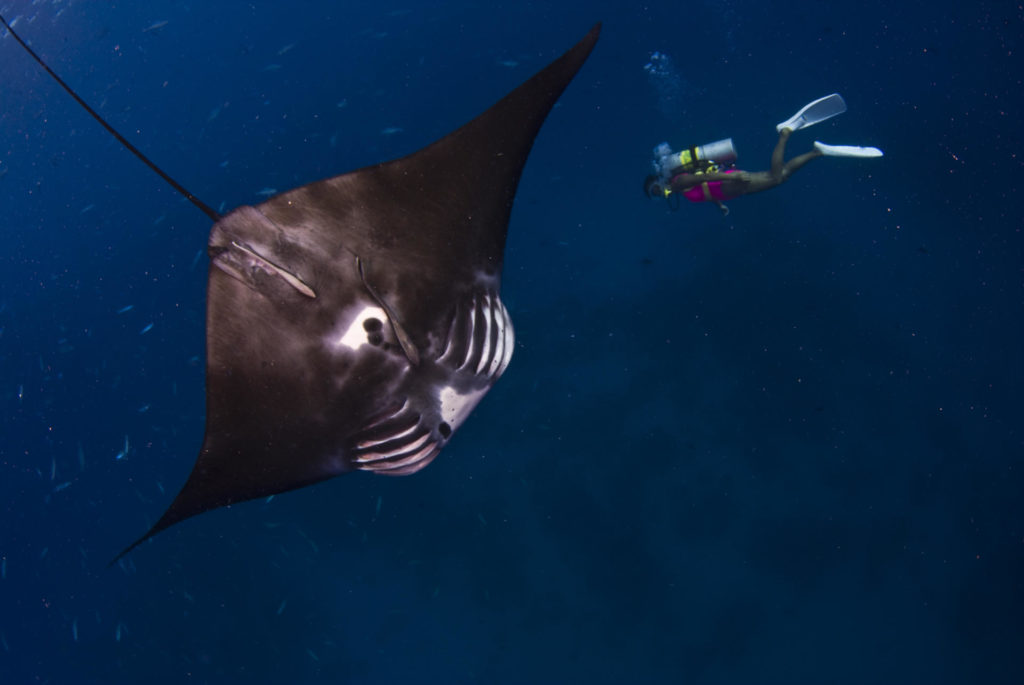
One manta had a mandible missing; probably caught in a fishing line or net. Our guide, Yoko Higashide, said she knew this manta; it cleaned here a lot. It used this station to clean and heal its wound and, now healed, has become attached to the site. Another ray had a snow-white belly. As the current increased, they chased each other around and continued feeding. It was a great way to start the day.
We had already dived twice by 9 a.m. as most dive boats were just heading out, we decided to see what the river held. Gnarly roots and an overhead canopy make this winding route fascinating. Snorkeling, we saw archerfish and odd root formations.
Flowers also floated down the stream as we snorkeled past. The upper part of the water is fresh and clear, but below there’s a halocline of sea water. It’s a fascinating habitat that is strange to look through, and we did so with a wary eye. The rivers in northern Palau hold estuarine crocodile, and we didn’t want to become croc lunch.
The islands of Palau are without a doubt one of the prettiest places on earth. Spanning more than 100 miles from one tip of the archipelago to the other, this region features an amazingly beautiful atoll, a high island called Babeldaob that in Micronesia is second only to Guam in terms of landmass. There are 700 rock islands and two southern limestone islands.
Many feel Babeldaob holds Palau’s unexplored attractions, both on land and along the outer reefs. The 53-mile Compact Road now encircling the island means the north side of the island can vie for attention with the south. The south’s drop-offs have been widely dived, but the north is now open and ready for the adventurous to explore.
Palau’s scuba diving is world famous, yet some of the fun you can have getting wet doesn’t involve diving. One of the most beautiful atolls in the world, and one of the most photographed, is Kyangel in northern Palau. It is the quintessential Pacific atoll, with a school of spinner dolphins living at the entrance channel mouth. Here you can try to snorkel with this resident pod and also visit the uninhabited, beach-lined, coconut grove islands in the atoll. Take a good guide and explore where few tourists visit.
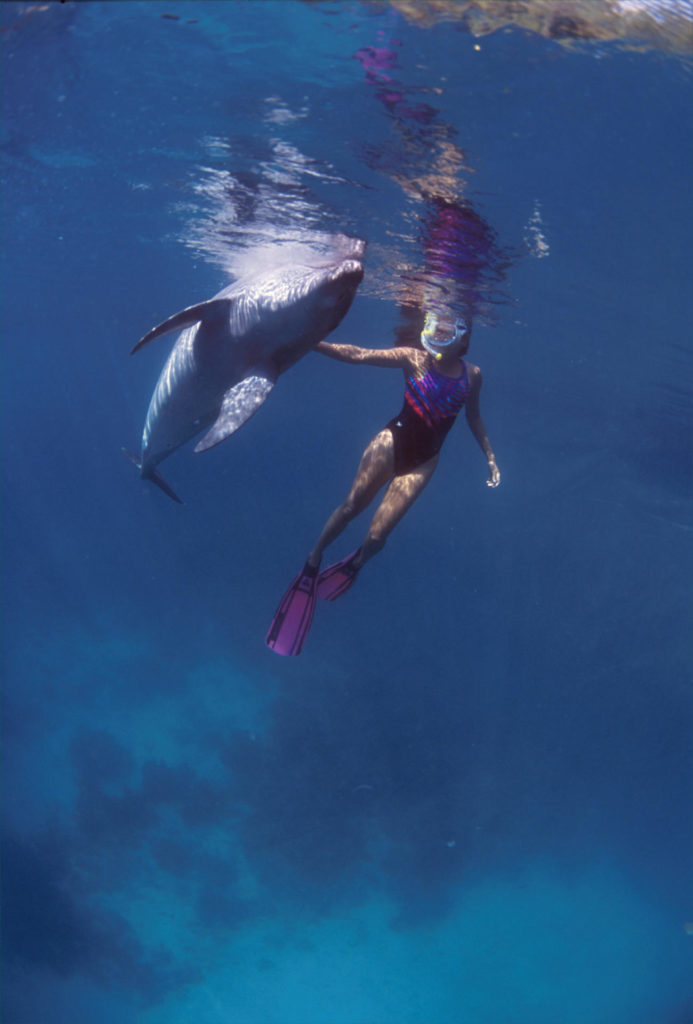
Don’t want to go quite this far? Then hop in a car and, in less than half an hour, you’ll pull into the new parking area for the spectacular central waterfalls of Babeldaob. The drive itself is pleasant as the road rolls over high vistas and down into deep island valleys. The highway is great for cycling as well.
Traffic is minimal so far, and the beauty of this island which had only coral and mud roads in the past, can now be more easily appreciated. The jungles hold fruit bats, small wood owls, lots of different birds and some odd insects that look like walking sticks.
The hike to the Ngardmau Falls used to run up a river along a canopied jungle path. With road access, it’s now all downhill. You can grab a hiking stick at the path entrance and trudge in. We hiked past the remnants of the pre-WWII bauxite mining area. Rails for the trains run through the jungle along steep valleys. An experienced guide may even be able to show you one or two of the trains that hauled the ore.
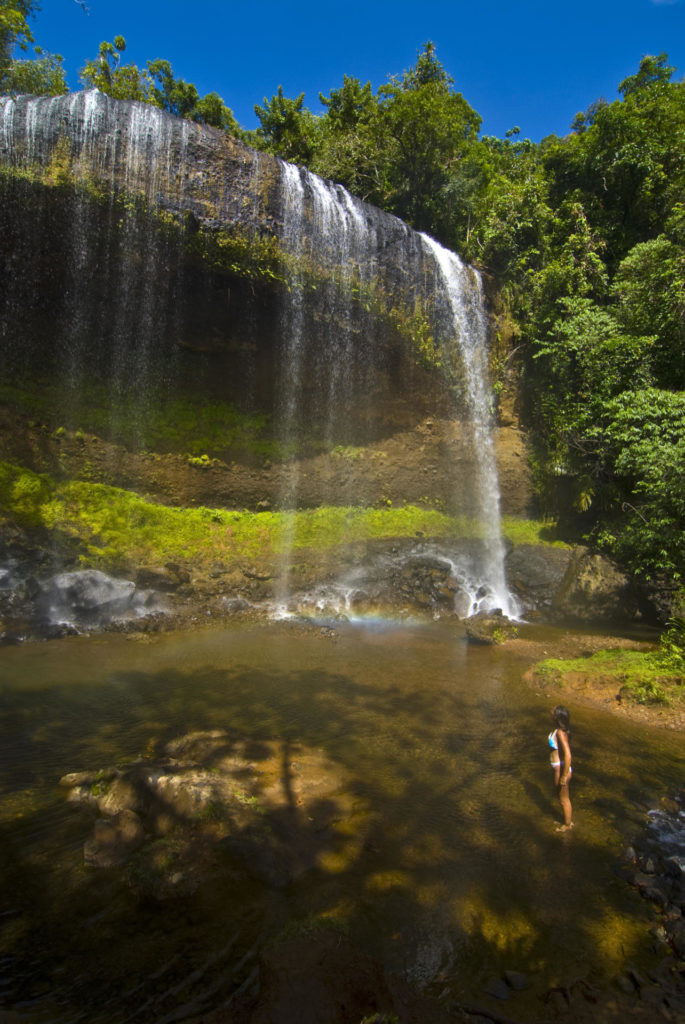
We had possibly the most experienced guide in Palau. Pioneer and Scuba Diving Hall of Fame member Francis Toribiong is the founder of Fish ‘n Fins. He discovered and explored the reefs, wrecks and land sites as a teenager in the late ’60s. He joined us and led us through a heavily overgrown ridgeline and rail track that ended at two locomotives. We marveled at these abandoned blasts from the past that have been sitting in jungle for more than 60 years.
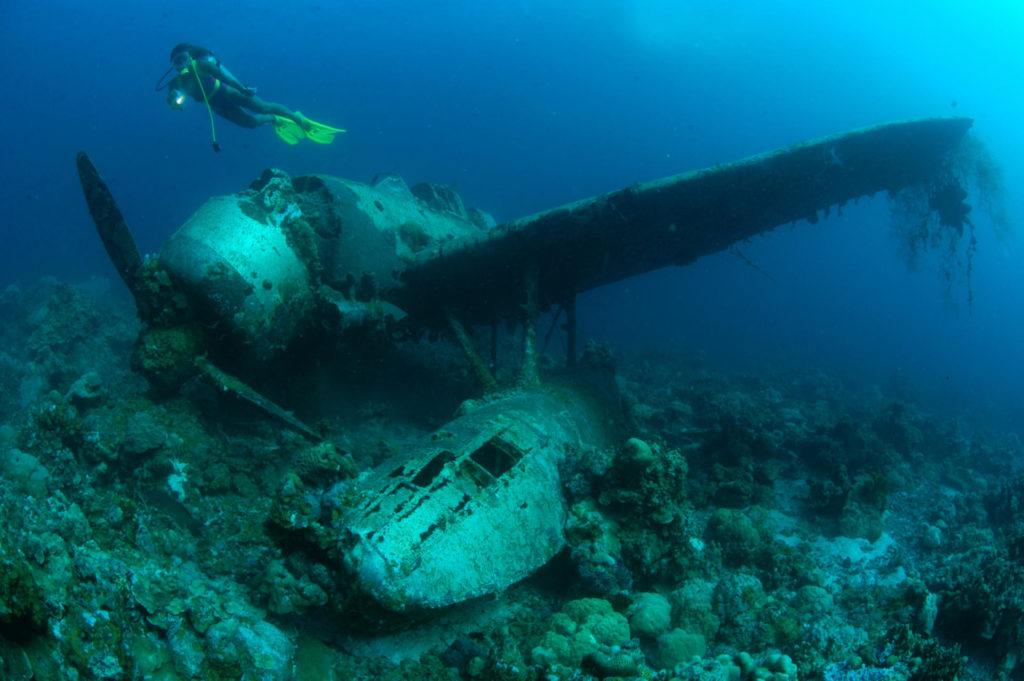
There’s an overlook where the falls are clearly visible down in the jungle. A steep trail heads down toward the falls. Along the way, a feeder river flows across broad rocky flats where you can jump in and cool off in smaller falls and deep pools where tiny fish and freshwater shrimp scurry about.
With the exception of a few ropes strung to make the descent along this part of the river safer, the river and falls area is pretty much left to nature. Some steps and a few shelters are found near the falls, so it not a simple trek. There’s still a swath of trail that can only be described as “Chocolate Avenue” of zōri-sucking mud.
The last leg is across a knee-deep river and over to the falls. They flow from Palau’s tallest peak, 713-foot high Mount Ngerchelechuus. The falls are at their best after a rain, and the hiking is the coolest when it is raining, so moisture from the sky shouldn’t deter the eager hiker.
As the cool, clear water beat down from the heights above, the falls massaged and refreshed us. We ran through the spray and got behind the falls. It’s a natural atrium and is truly one of the Pacific’s best attractions. Relax, cool off and store up some energy. Bring plenty of water, as the hike back is all uphill.
There are other falls on this island, such as the popular Ngatpang Waterfall. There’s also a freshwater lake yet to be explored and rumored to be chock full of crocodiles.
Back on land, you can also arrange to take a boat or kayak out from Ngeremlengui Village. The Ngermeskang River is unspoiled beauty, ranging in habitat from a mangrove forest at its mouth to a dense jungle farther inland. This river is wonderful for nature lovers and adventure seekers alike.
Here we jumped out of the boat and swam to shore. We hiked up the banks and found the remnants of the Japanese pineapple cannery where wild pineapples still grow. This is where kayakers can sneak up on saltwater crocodiles.
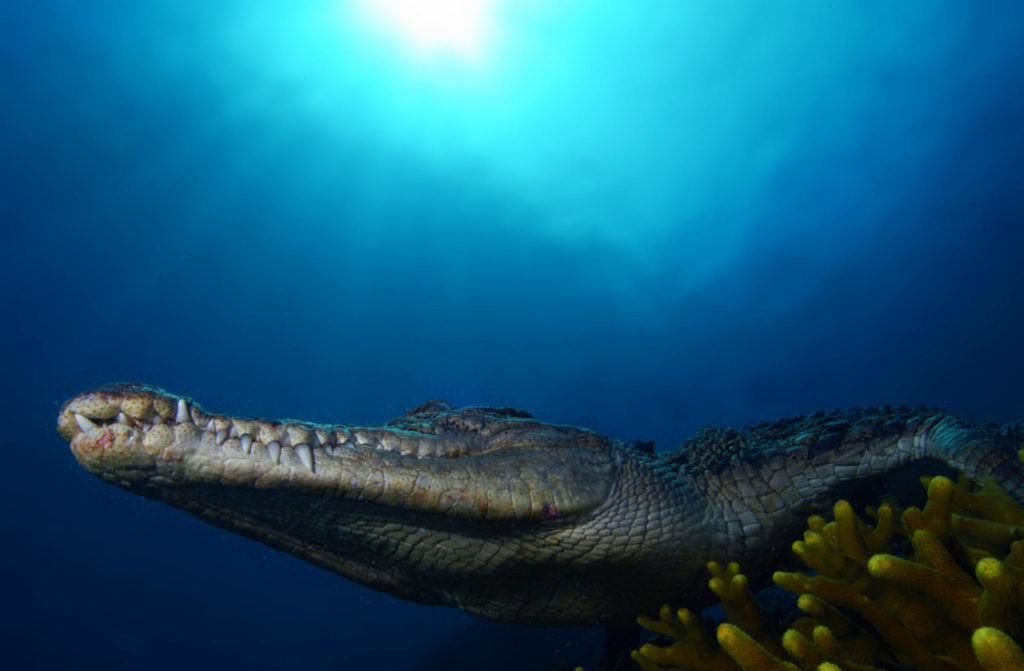
Speaking of crocs, the eastern side of the island has a jungle river tour fairly famous for croc sightings. The Ngerdorch River winds its way through the jungle and ends up opening into the ocean. Along the way there’s ancient fern trees, wild orchids and cannon ball trees.
In the rare mangrove forests live endemic birds such as the Palau fruit dove and rusty capped kingfisher. It is here some of the wild crocs have become habituated to getting handouts of chicken from the cruise. The crocs can come up vertically from the water, so keep your elbows inside the boat.
Back to scuba—another great northern dive rarely done in Palau is the Ngeremlengui Channel, or The West Passage, off West-Central Babeldaob. This has been the only place that a mesekiu, or Palauan dugong, has been photographed underwater.
Swift currents mean exciting drifts along steep walls adorned in big coral fans and multi-hued soft corals. Look for big sharks to be drifting by and sea turtles to be munching on hydroids.
A short climb into the rock islands of Babeldaob brings you to the Metuker ra Bisech, a quarry of Yapese stone money. These wheel-like pieces of stone sometimes measured more than a meter in diameter. Some still sit in the jungle.
We spent the lazy afternoon exploring the final resting sites of Jake-Aichi floatplanes. They sit barely beneath the water on the Babeldaob side of the new bridge. One of the Jakes sits near the cave where the last crocodile to kill a man (1965) in Palau was hunted down. The plane is scattered but the prop and engine are visible.
One day trip specially choreographed for extreme adventurers is the Planet Blue Tarzan Tour. Rope swings, cavern free dives and marine tunnels ensure an action-filled day. Beginning in the isolated Lost Lake, we paddled through a 40-foot tunnel carpeted with soft corals into the inner world of the marine lake.
You then navigate a labyrinth of islands west of Ngeruktabel, drift into Belochel Bay and, as the tide continues to drop, snorkel with dive lights into the darkness of a secret tunnel passage to the secluded Tarzan Lake.
A free dive (using a snorkel) into the shadows of a limestone cave is followed by seeing the multi-chambered cavern. It features hanging stalactites, soda straws and the “Ice Room.” Top off the exhilarating day by leaping into the sea from towering outcrops.
Close to Koror is the world’s largest captive dolphin facility nestled into a beautiful Rock Island setting. Here bottlenose dolphins frolic and perform amazing acrobatics. If you didn’t have any luck with the Kyangel spinner dolphins, here you will be guaranteed to swim with, touch and communicate with big bottlenose dolphins in a very natural reef setting.
The dolphins love to play, and one of the more advanced tours offers you a chance to be one-on-one or, in our case, one-on-two with them. Yoko was able to dive down and swim along the sea floor, get a free ride on the dolphin’s dorsal and shoot up to the surface, flanked on both sides by the playful bottlenose buddies.
Of course, one can’t miss the big two must-see dive sites in the south. There is a world-class dive site called Blue Corner. This is considered one of the world’s best boat dives. The south also has German Channel, a favorite spot to watch manta rays feed and big schools of jacks and snapper congregate. Plus, there’s the Rock Islands, one of the most beautiful natural formations in the world.
Blue Corner diving is addictive. Dive when the tide changes and the current is moving for the most action. It seems the stronger the current, the more action you’ll find. We started along a steep wall and immediately gray reef sharks cruised by to see what we were doing while our guide chose to stay out in the blue water. Here we found dense shoals of bigeye jacks and blackbar barracuda.
Gray reef and white reef sharks routinely cruised by between the reef wall and us. Then, off in the distance, we saw a massive wahoo. This big game fish would have been a trophy for any angler. We eventually made our way to the Corner, gliding through a dense cloud of snapper and into a group of longnose barracuda. Fishy, fast and fun; that’s Blue Corner.
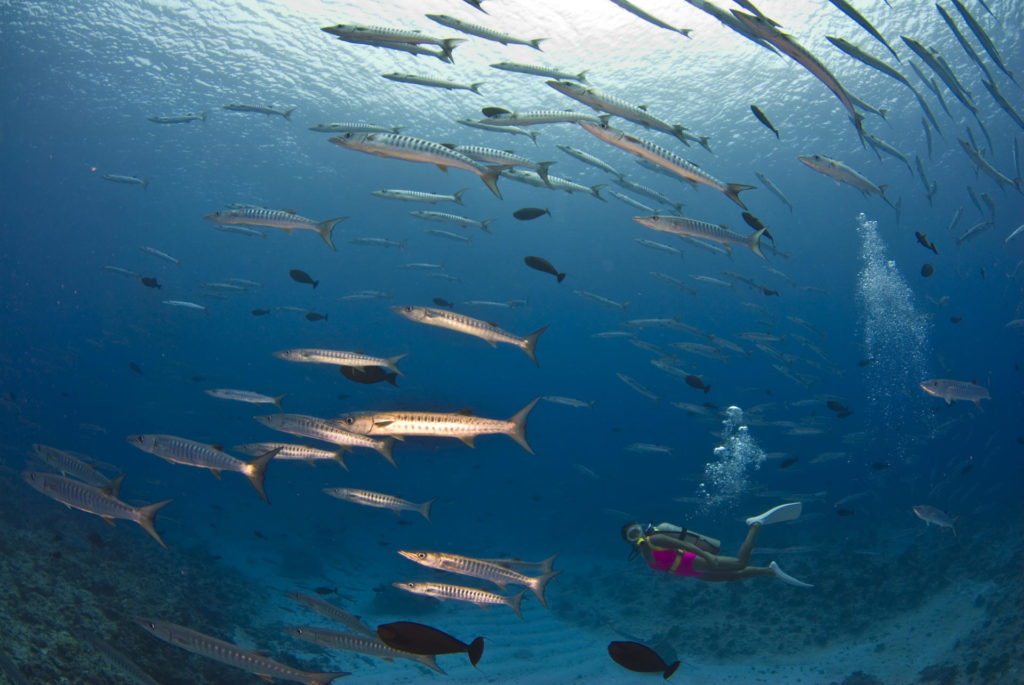
The next day, we timed our dive for the incoming tide at German Channel. When the thick school of red snapper there start to feed, it gets exciting as well. A sailfish cruised by above us; its sail almost out of the water. Manta rays come into the channel at this time to eat the open water plankton shoveled through the channel passage.
Mouths agape, they eat and swoop. We hung out at six meters and just watched the show. They barrel-rolled and did “aquabatics” no other fish can do. At the end, they were full of food and we, too, had had our fill of excitement.
Most of the major tour and dive operations now offer various forms of land tours to the north. Diving here and snorkeling is bound to also increase as an alternative to the popular southern dive sites. It’s still largely untouched and exploration is in its infancy.
In the evenings the last call of native birds echoes down the Babeldaob river valleys. Clouds hang low over the jungle and they glow with the warm gold of the sunset.
We sat high on a hill, looking out to the barrier reef and Devilfish City. We listened to the breeze blow over the northern hills. “Palau is full of surprises,” Toribiong told me, and the north will surely produce more as the years go by.
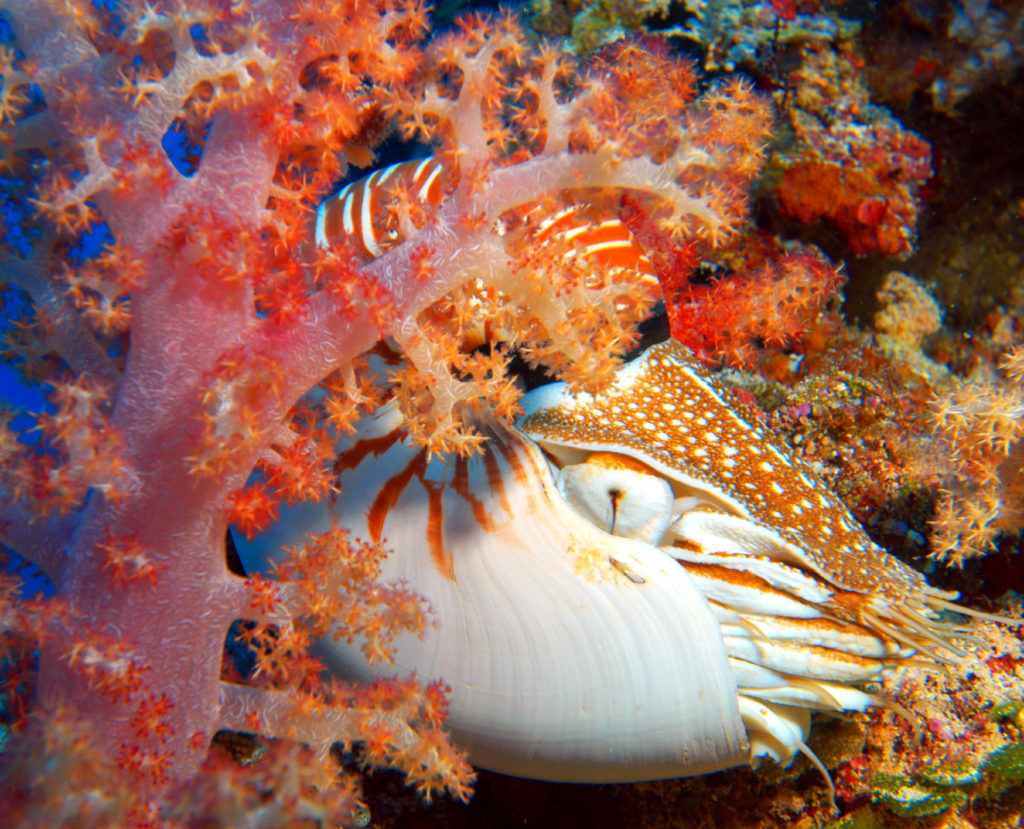
Compact Road?
Palau’s Compact Road got its name because it was built under an agreement called the Compact of Free Association, under which Palau negotiated its independent status from the USA (1986). The Department of the Interior contracted the U.S. Army Corps of Engineers to plan, design and manage construction of the road. When it opened in October of 2007, it was touted as Palau’s $150 million “Road to the Future.” Until then, Babeldaob’s northern and inner reaches were difficult to reach except by boat.
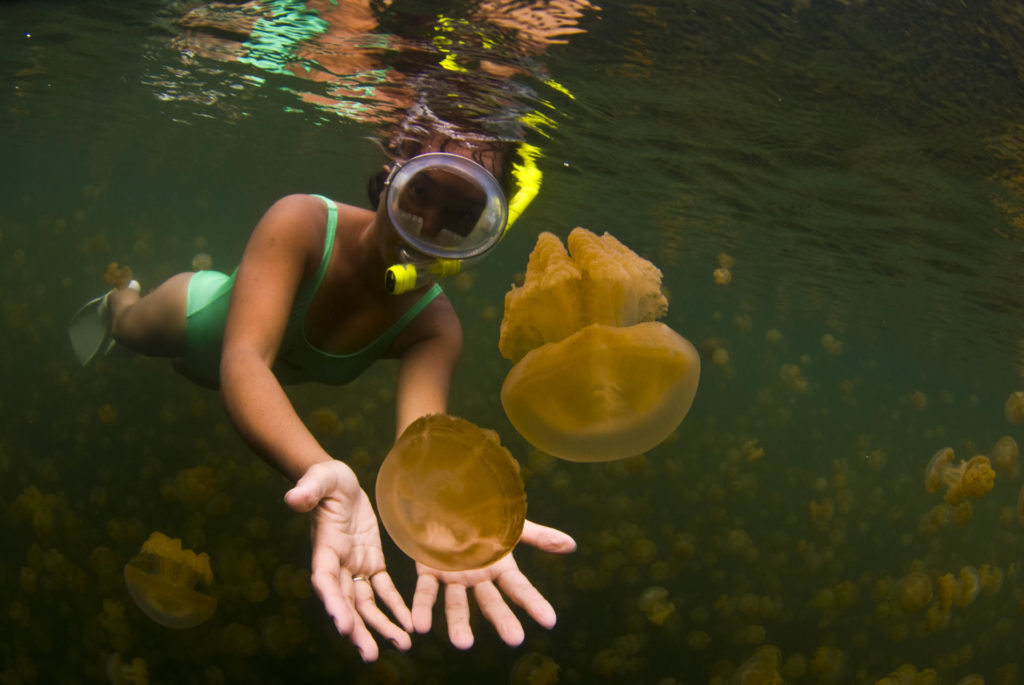
TRAVELER INFO
- Language: English is the official language and is commonly spoken and understood. Many elderly people are also fluent in Japanese.
- Getting There: Continental Airlines has daily flights to Palau from Japan or Hong Kong via Guam.
- Getting Around: Taxis are plentiful and can be called to most locations but are not cheap. Rental cars, buses and local boats are available.
- Entry & Exit: Visitors must have a valid passport. A departure tax of US$20 cash is payable at check-in before receiving a boarding pass. Save some extra cash, as credit cards are not accepted.
- Money, Banking and Credit Cards: The U.S. dollar is the official currency. There are several U.S. FDIC insured banks operating in the Federated States of Micronesia. Most major credit cards are welcome at visitor-oriented businesses.
- Time: Palau is 10 hours ahead of GMT.
- Electricity: Standard 110 volt and U.S. type outlets are used. Adapters and converters will be needed and aren’t readily available for those with 220 systems, so best to bring your own.
- Weights & Measures: The U.S. system of weights and measures is used. Depths are registered in feet and weights in pounds. All dive gear is oriented this way.
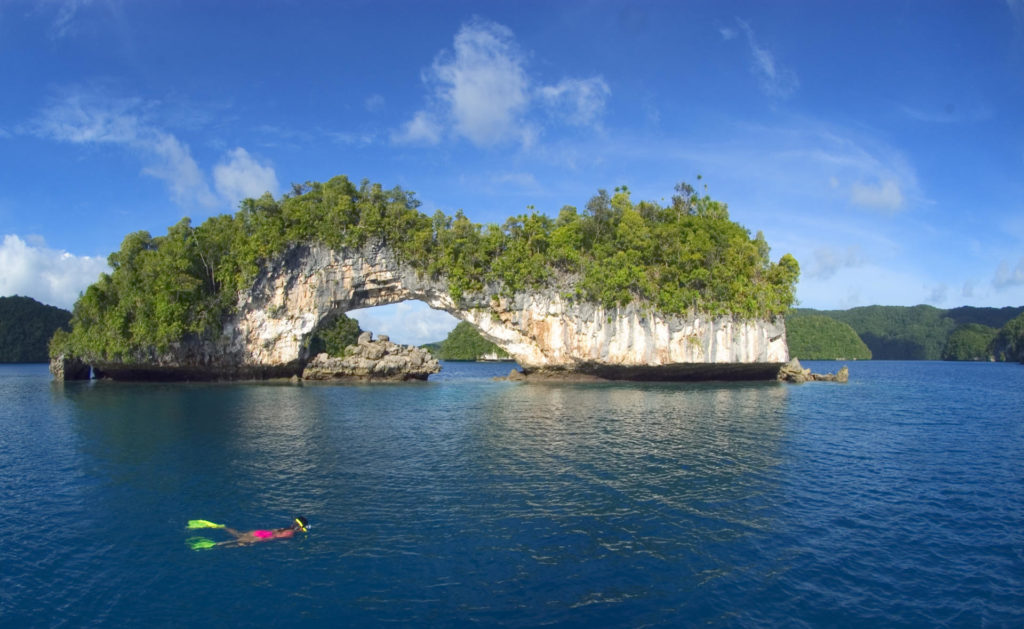
TRAVELER “IN-SITES”
- Fish ‘n Fins: www.fishnfins.com
- Planet Blue Tarzan Tour: www.samstours.com
- Palau Visitors Authority: www.visit-palau.com




